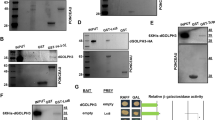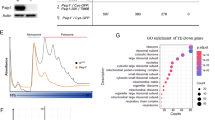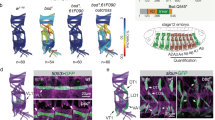Abstract
Regulating ribosome number is thought to control cellular growth1. Synthesis of ribosomal RNA (rRNA) is a limiting step in ribosome biogenesis and rates of rRNA synthesis are generally altered depending on the growth status of a cell2,3. Although studies in unicellular systems have addressed the mechanisms by which this occurs4,5, few studies have applied a genetic approach to examine growth-dependent control of rRNA synthesis in metazoans. Here, we show that in Drosophila melanogaster Myc (dMyc) is a regulator of rRNA synthesis. Expression of dMyc is both necessary and sufficient to control rRNA synthesis and ribosome biogenesis during larval development. Stimulation of rRNA synthesis by dMyc is mediated through a rapid, coordinated increase in the levels of the Pol I transcriptional machinery. In addition, the growth effects of dMyc in larval wing imaginal discs require de novo rRNA synthesis. We suggest that during animal development, the control of rRNA synthesis and ribosome biogenesis is an essential Myc function.
This is a preview of subscription content, access via your institution
Access options
Subscribe to this journal
Receive 12 print issues and online access
$209.00 per year
only $17.42 per issue
Buy this article
- Purchase on Springer Link
- Instant access to full article PDF
Prices may be subject to local taxes which are calculated during checkout





Similar content being viewed by others
References
Rudra, D. & Warner, J.R. What better measure than ribosome synthesis? Genes Dev. 18, 2431–2436 (2004).
Grummt, I. Life on a planet of its own: regulation of RNA polymerase I transcription in the nucleolus. Genes Dev. 17, 1691–1702 (2003).
Moss, T. & Stefanovsky, V.Y. At the center of eukaryotic life. Cell 109, 545–548 (2002).
Warner, J.R. The economics of ribosome biosynthesis in yeast. Trends Biochem. Sci. 24, 437–440 (1999).
Nomura, M. Regulation of ribosome biosynthesis in Escherichia coli and Saccharomyces cerevisiae: diversity and common principles. J. Bacteriol. 181, 6857–6864 (1999).
Saucedo, L.J. & Edgar, B.A. Why size matters: altering cell size. Curr. Opin. Genet. Dev. 12, 565–571 (2002).
Seifarth, W. et al. Identification of the genes coding for the second-largest subunits of RNA polymerases I and III of Drosophila melanogaster. Mol. Gen. Genet. 228, 424–432 (1991).
Campbell, G. & Tomlinson, A. The roles of the homeobox genes aristaless and Distal-less in patterning the legs and wings of Drosophila. Development 125, 4483–4493 (1998).
Lambertsson, A. The minute genes in Drosophila and their molecular functions. Adv. Genet. 38, 69–134 (1998).
Grandori, C., Cowley, S.M. James, L.P. Eisenman, R.N. The Myc/Max/Mad network and the transcriptional control of cell behavior. Annu. Rev. Cell. Dev. Biol. 16, 653–699 (2000).
Gallant, P., Shiio, Y., Cheng, P.F., Parkhurst, S. M. & Eisenman, R. N. Myc and Max homologs in Drosophila. Science 274, 1523–1527 (1996).
Johnston, L.A., Prober, D. A., Edgar, B. A., Eisenman, R. N. & Gallant, P. Drosophila myc regulates cellular growth during development. Cell 98, 779–790 (1999).
Maines, J.Z., Stevens, L.M., Tong, X. & Stein, D. Drosophila dMyc is required for ovary cell growth and endoreplication. Development 131, 775–786 (2004).
Schreiber-Agus, N. et al. Drosophila Myc is oncogenic in mammalian cells and plays a role in the diminutive phenotype. Proc. Natl Acad. Sci. USA 94, 1235–1240 (1997).
Pierce, S.B. et al. dMyc is required for larval growth and endoreplication in Drosophila. Development 131, 2317–2327 (2004).
Moberg, K.H. Mukherjee, A., Veraska, A., Artavanis-Tsakonas, S. & Hariharan, I.K. The Drosophila F Box protein Archipelago regulates dMyc protein levels in vivo. Curr. Biol. 14, 965–974 (2004).
Moreno, E. & Basler, K. dMyc transforms cells into super-competitors. Cell 117, 117–129 (2004).
de la Cova, C., Abril, M., Bellosta, P., Gallant, P. & Johnston, L.A. Drosophila myc regulates organ size by inducing cell competition. Cell 117, 107–116 (2004).
Orian, A. et al. Genomic binding by the Drosophila Myc, Max, Mad/Mnt transcription factor network. Genes Dev. 17, 1101–1114 (2003).
Zaffran, S. et al. A Drosophila RNA helicase gene, pitchoune, is required for cell growth and proliferation and is a potential target of d-Myc. Development 125, 3571–3584 (1998).
Perrin, L., Benassayag, C., Morello, D., Pradel, J. & Montagne, J. Modulo is a target of Myc selectively required for growth of proliferative cells in Drosophila. Mech. Dev. 120, 645–655 (2003).
Kim, S., Li, Q., Dang, C.V. & Lee, L.A. Induction of ribosomal genes and hepatocyte hypertrophy by adenovirus-mediated expression of c-Myc in vivo. Proc. Natl Acad. Sci. USA 97, 11198–11202 (2000).
Boon, K. et al. N-myc enhances the expression of a large set of genes functioning in ribosome biogenesis and protein synthesis. EMBO J. 20, 1383–1393 (2001).
Coller, H.A. et al. Expression analysis with oligonucleotide microarrays reveals that MYC regulates genes involved in growth, cell cycle, signaling, and adhesion. Proc. Natl Acad. Sci. USA 97, 3260–3265 (2000).
Guo, Q.M. et al. Identification of c-myc responsive genes using rat cDNA microarray. Cancer Res. 60, 5922–5928 (2000).
Schlosser, I. et al. A role for c-Myc in the regulation of ribosomal RNA processing. Nucleic Acids Res. 31, 6148–6156 (2003).
Lieb, J.D., Liu, X. Botstein, D. & Brown, P. O. Promoter-specific binding of Rap1 revealed by genome-wide maps of protein-DNA association. Nature Genet. 28, 327–334 (2001).
Jorgensen, P., Nishikawa, J.L., Breitkreutz, B.J. & Tyers, M. Systematic identification of pathways that couple cell growth and division in yeast. Science 297, 395–400 (2002).
Gomez-Roman, N., Grandori, C., Eisenman, R.N. & White, R.J. Direct activation of RNA polymerase III transcription by c-Myc. Nature 421, 290–294 (2003).
van Steensel, B. & Henikoff, S. Identification of in vivo DNA targets of chromatin proteins using tethered dam methyltransferase. Nature Biotechnol. 18, 424–428 (2000).
Lee, T. & Luo, L. Mosaic analysis with a repressible cell marker (MARCM) for Drosophila neural development. Trends Neurosci. 24, 251–254 (2001).
Prober, D.A. & Edgar, B.A. Ras1 promotes cellular growth in the Drosophila wing. Cell 100, 435–446 (2000).
Polymenis, M. & Schmidt, E.V. Coupling of cell division to cell growth by translational control of the G1 cyclin CLN3 in yeast. Genes Dev. 11, 2522–2531 (1997).
Daga, R.R. & Jimenez, J. Translational control of the cdc25 cell cycle phosphatase: a molecular mechanism coupling mitosis to cell growth. J. Cell Sci. 112, 3137–3146 (1999).
Derenzini, M. et al. Nucleolar function and size in cancer cells. Am. J. Pathol. 152, 1291–1297 (1998).
Ruggero, D. & Pandolfi, P.P. Does the ribosome translate cancer? Nature Rev. Cancer 3, 179–192 (2003).
Aris, J.P. & Blobel, G. Identification and characterization of a yeast nucleolar protein that is similar to a rat liver nucleolar protein. J. Cell Biol. 107, 17–31 (1988).
Acknowledgements
The authors would like to thank L. Saucedo, C. Grandori and R. White for helpful advice and comments on the manuscript and C. Grandori and R. White for sharing unpublished data. S.S.G. is supported by a research fellowship from the SASS Foundation for Medical Research. A.O. is a Leukemia & Lymphoma Society Special Fellow. R.N.E is an American Cancer Society Research Professor. This work was supported by a National Institutes of Health (NIH)/National Cancer Institute grant R01CA57138 (to R.N.E.) and an NIH grant GM51186 (to B.A.E).
Author information
Authors and Affiliations
Corresponding author
Ethics declarations
Competing interests
The authors declare no competing financial interests.
Supplementary information
Supplementary information S1
Supplementary figures S1, S2 and S3 (PDF 241 kb)
Supplementary information S2
Supplementary table S1 (PDF 102 kb)
Rights and permissions
About this article
Cite this article
Grewal, S., Li, L., Orian, A. et al. Myc-dependent regulation of ribosomal RNA synthesis during Drosophila development. Nat Cell Biol 7, 295–302 (2005). https://doi.org/10.1038/ncb1223
Received:
Accepted:
Published:
Issue Date:
DOI: https://doi.org/10.1038/ncb1223
This article is cited by
-
Aneuploidy during development in facultative parthenogenetic Drosophila
Heredity (2024)
-
Altered vitamin B12 metabolism in the central nervous system is associated with the modification of ribosomal gene expression: new insights from comparative RNA dataset analysis
Functional & Integrative Genomics (2023)
-
MYC sensitises cells to apoptosis by driving energetic demand
Nature Communications (2022)
-
The emerging role of NOTCH target genes in Egyptian childhood acute lymphoblastic leukemia
memo - Magazine of European Medical Oncology (2021)
-
ERK signalling: a master regulator of cell behaviour, life and fate
Nature Reviews Molecular Cell Biology (2020)



